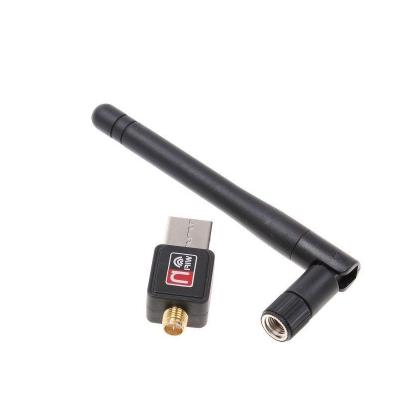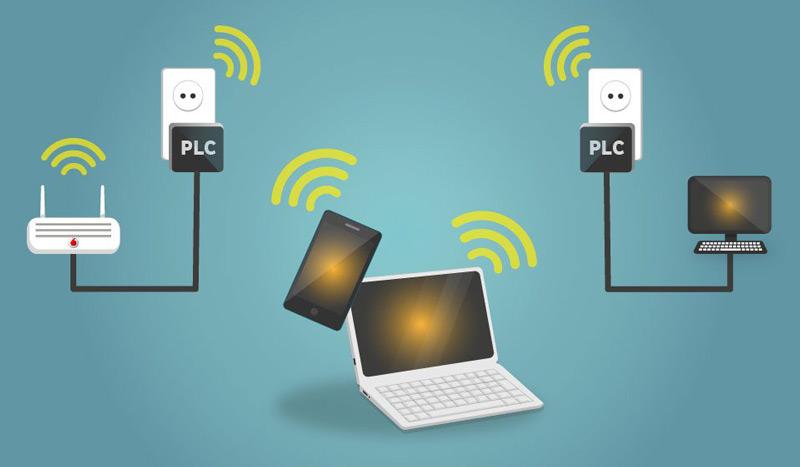
Index:
UPDATED ✅ Do you have doubts about which device is better to connect to Wifi and want to know the differences and similarities? ⭐ ENTER HERE ⭐ and discover which one is better ✅ EASY and FAST ✅
Having a good internet connection is something we all aspire toboth at home and in the office. Currently, many technologies are combined to achieve this purpose. PLCs and WiFi adapters compete to be the pioneer tool in providing connectivity.
in this post I will make a comparison between these two technologies, to help you choose which one to use. Also, I will show you the features, advantages and disadvantages of each one, with a series of essential recommendations, which you cannot stop reading.
Follow me until the end of the reading so that you don’t miss any details, surely in the end you will know how to notice the difference between this type of hardware that improves our connectivity to the WWW.
Differences between a PLC and a WiFi adapter
Although there are many similarities between these two technologies, and many tend to confuse them, there are marked differences. Based on this, we will analyze what is a PLC and what is a WiFi adapter so you have your own perspective:
What is a PLC?

It is a technology that allows us to transmit the internet through the electrical wiring of our homes. The acronyms it represents refer to Power Line Communications.
With this type of installation, we will have to add more cables to share the internet on all our computers. The electrical network of our home will serve as a platform for data flow.
This technology has been on the market for more than a decade, and has become more popular every day. This is because companies save costs by not having to install new wired infrastructure.
How does it work?
Surely you will wonder how it is possible that the internet and the electric current go through the same conductor. This is so thanks to frequency and voltage filters incorporated in these devices.
On the one hand the data travels, with a very high frequency between 2 and 4 MHz, and with a very low voltage. On the other hand, the electric current is filtered with a voltage that goes from the 110V up to 220V.
In this way, the data that circulates through the wiring continuously is decoded. It is important to note that for a direct connection to a PLC network, UTP cables are required to connect our computer to the network.
What is a Wi-Fi antenna?

A WiFi antenna is a device designed to search for and boost signals from wireless networks nearby. This with the intention of increasing the availability and connectivity of the Internet at each point.
This type of technology is ideal for wireless or mixed networks that have been installed in your home or office. In fact, WiFi adapters are used in many large locations to save on the cost of cabling and accessories involved in expanding a wired network.
How does it work?
The How WiFi adapters work It is based on the recognition of the frequencies of networks arranged in the surroundings.
Some WiFi antennas can work with a direct coaxial connection, or also connected to a USB port. They are light, practical, and easy to install. In general, they do not require prior installation software, since they adapt and mesh with your network card.
When you install it, the available networks to establish a connection will appear in the network interface of your computer. The power with which the adapter receives the signal will depend on its brand or model, but it can be up to ten times higher than the conventional signal.
Pros and cons of PLCs
To analyze which technology is the best for you, I have analyzed and discovered the pros and cons of both tools.
We’ll start by looking at all about PLCs:
Advantage
- Easy installation: All you have to do is plug the device into the electrical network, and that’s it. You will not need greater efforts or hours of work.
- Wiring savings: You will not have to buy cables of any kind, since the electrical network itself works as a platform.
- Greater distances without interruption: This type of technology can work over relatively long distances without the need for interruption or interference.
- Greater privacy of your network: Strangers are unlikely to join your network as it is a private circuit.
- It does not decrease with the presence of walls or walls: Obstacles such as walls and walls are not a problem with PLCs.
Disadvantages
- The browsing speed is lower: Although the connectivity is more stable, the data transfer speed is lower.
- Limited access on some devices: Directly you will not be able to connect smartphones or tablets to the network. For this you will have to use a WiFi repeater or router.
- Some voltage variations can affect connectivity: If there are imbalances in the electrical network voltage, or any failure or storm, there may be interference.
- The more teams the more interference: Every time you add one more piece of equipment to the network, there is a greater risk of interference.
Pros and cons of WiFi adapters
In the same way, also I want to show you the positives and negatives of using a WiFi device to increase the power of the internet. Let’s see:
Advantage
- Simplicity: The installation and management is very simple, you do not require advanced knowledge for its management.
- High compatibility: You will be able to share and receive data from any digital device with wireless capability.
- Low cost: It is an investment that in the future will provide you with savings in terms of connectivity or the purchase of cables.
- Versatility: you will be able to reorganize and even move your WiFi adapter without problems from one place to another according to your needs.
- Wireless: You will not have to worry about buying any cables, or any interruption due to cut or obstructed cables.
Disadvantages
- It is diminished with distance: The further away you will have less signal strength.
- Walls and obstacles are a problem: With walls, walls, and dense objects, you will have less signal availability, and the network is affected.
- Vulnerability: WiFi connections are the ones that receive the most attacks because they are accessible and visible to everyone. This can affect all levels and nodes of the network.
- It is not recommended on different floors of a building: If you want to extend the signal from one floor to another, WiFi adapters are not as effective.
When to use a PLC or a WiFi adapter? your doubts resolved

There are different methods to share the internet in a given area, depending on its extension or characteristics. Companies that provide internet they usually use wiring of different types to achieve their objective.
These might be:
- Optical fiber.
- Coaxial cable.
- twisted pair
These companies include wireless technologies such as Wi-Fi in your distribution process. However, in our home or workplace we can do more to optimize internet access on all computers.
WiFi transmitters and PLCs are very functional alternatives that can be used in the following cases:
- When we need to distribute the internet to a large area of worked.
- In case of multi-storey infrastructure.
- When you notice that an area of your office or home is not receiving a good connection.
- If you want to integrate a network between two adjoining blocks or flats.
In each of these cases you will have the uncertainty of choosing between a PLC or a WiFi device. then i show you what are the differences between these two tools so you can choose the most convenient for your network.
There are very specific situations where one of these specific methods can be used. That is why I will show you this list of situations where it is more convenient to lean towards one of the two methods.
When to use a PLC?
- In multi-storey buildings.
- When there are many obstacles between the different areas.
- If you will not use other equipment such as Smartphone or Tablet that require WiFi.
- For simple point-to-point connections.
When to use a WiFi adapter?
- If you want to increase connectivity on the same floor.
- When you need to connect several devices whose connection method is WiFi.
- If you notice that there is any fault or inconsistency in your electrical installation.
How to increase internet coverage at home by combining both devices?

The two technologies are not necessarily mutually exclusive. You may combine both to achieve harmony and excellent connectivity. In fact, the best thing to do when using a PLC is to use WiFi repeaters to achieve complete distribution. For it you can use a router in any outlet where you install a PLC.
Some PLCs already include WiFi repeaters to achieve full coverage. A) Yes, with the installation on your computer of a WiFi antenna, you will have a more direct access to the network. You won’t have to worry about distances and obstacles, and you can be permanently connected.
my personal recommendation, is that you carefully evaluate the characteristics of your home or office, as well as those of your network. In this way, you will have the possibility to determine with certainty which technology to useor if it is convenient for you to combine them.
So far our Comparative guide between PLCs and WiFi adapters. Stay tuned for our publications so that you are updated on everything related to digital technology.
networks